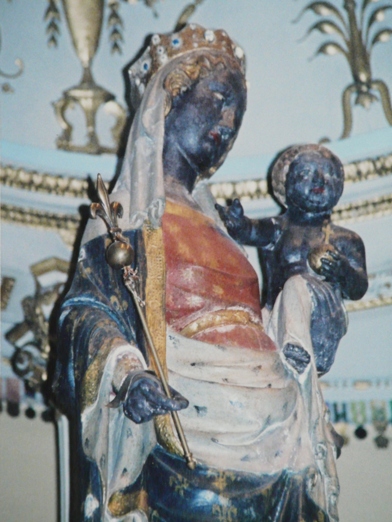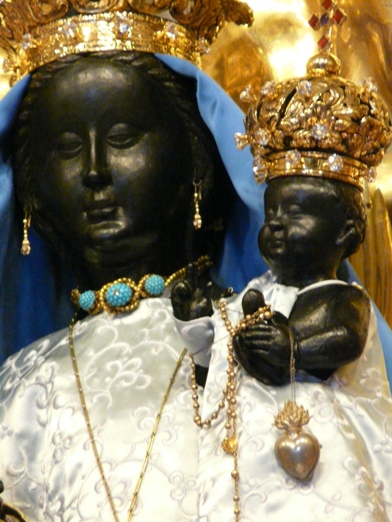Of all the varied aspects of African womanhood, none are more fascinating than the hundreds of representations of Black Madonnas. Indeed, the Black Madonnas of Europe are perhaps the most venerated icons in all of European Christendom. Their shrines have attracted millions of devotees. They are thought to be miracle workers, and their miracle-working powers are derived from their blackness.
In Russia during the nineteenth century, the celebrated Russian General Kutuzov had his army pray before the Black Madonna of Kazan before the historic battle with the Napoleonic army at Borodino. The same Madonna is said to have inspired Rasputin and may now be in the United States. At least two major paintings of Black Madonnas are on display in the Kremlin, in Moscow.
In reference to La Moreneta (the Little Black Lady), the Black Madonna of Montserrat, Spain – more than 1,000 years old and the patroness of the Catalonian region, it is said “He is not well wed who has not taken his wife to Montserrat.” She is in charge of sexuality and fertility, and presides over weddings and childbirth. In the mountains north of Barcelona, La Moreneta’s shrine has attracted millions of visitors, including pope John Paul II. Both Goethe and Schiller attached great importance to Montserrat.
France probably has more representations of Black Madonnas than any other country. France has more than 300 representations of Black Madonnas, a chief center of which is Chartres – a small quiet town about 85 kilometers southwest of Paris. The most notable of the Black Madonna images in Chartres is called Notre-Dame du Pilier (Our Lady of the Pillar). This representation, about a meter high, of a Black Madonna statue made of natural wood placed on a pillar holding the infant Jesus. Both the Madonna and Child are colored a very dark brown and are dressed in white robes embroidered with gold. The images are highly venerated, especially among Catholics, and I confess that even I, out of respect, got down on both knees during my two visits to the cathedral and whispered a prayer.
The cathedral at Chartres is a large and magnificent edifice more than 800 years old and possessing marvelous original blue stained glass windows, at least two of which have Black Madonna figures right in the center. A copy of an original Black Madonna statue stands in a crypt underneath the main cathedral.
Many believe that the Black Madonnas of Europe represent vestiges of the adoration of the African goddess Ast, better known as Isis. Notre Dame Cathedral, the Cathedral of Our Lady of Paris, considered a masterpiece of Gothic architecture and at the very center of Paris, was built directly over an ancient temple of this supreme African deity. Indeed, it has been noted the name of Paris itself is derived from Park of Isis.
In the quiet Chapel of the Congregation of S. Thomas of Villeneuve in a serene setting in the Parisian suburb of Neuilly-sur-Seine, stands one of the most important of the Black Madonna statues. She is La Vierge Noire de Paris (the Black Virgin of Paris) and consists of a two meter-high standing statue, carved of a single block of hard limestone, of a smiling Black Madonna holding the Christ child (the infant wears closely cropped nappy blond hair) and wielding a kind of wand or scepter capped by the flour de lys – symbol of the French monarchy. Atop her head sits a gold crown embedded with precious stones. The statue is dressed in a gown of rich red, blue, and white colors, the colors of the French flag. The Christ child himself is holding a golden cross and the entire image is believed to be more than 500 years old, and probably replaced a much earlier one.
One of the most important Black Madonnas in France is Our Lady of Le Puy. Located in the southern part of France, the statue may have originally been that of Ast/Isis. At Le Puy pope Urban II held council to prepare for the First Crusade. Joan of Arc sent the knights that accompanied her from Vaucouleurs to Chinon, along with her mother and two brothers, to Le Puy to pray there.
Our Lady of Rocamadour, a Black Madonna carved of walnut wood, is believed to be more than 1,000 years old. She is said to resuscitate babies, protect sailors, free captives, and promote fertility. To reach her shrine in southwest France one must climb 216 steps. Among her more notable visitors have been St. Louis of France and Henry II of England.
La Negre, the Black Madonna of Montpellier, is one of the most notable of the Black Madonnas of France. She is said to have been performing miracles since 878 and is believed to have saved Montpellier from drought and plague.
Other famous Black Madonnas are found scattered throughout Europe, with some of the most notable examples in Germany, Belgium, Italy, Switzerland, and Poland. Of the hundreds of Black Madonnas which presently exist at assorted shrines in Europe, some are especially significant.
Our Lady of Hal, in the Church of St. Martin, just outside of Brussels, Belgium, dating from the early thirteenth century, is made of walnut, is believed to have defended the town on numerous occasions. Her visitors have included Henry VIII of England and Louis XII of France. The Black Madonna is believed to have saved Brussels from attackers in 1580, when she intercepted numerous cannon balls in her lap. The cannon balls can still be seen on display in the church. She is believed to heal sickness and restore the dead and buried to life. Her pilgrimage and procession are on the first Sunday in September.
Our Lady of the Hermits in Einsiedeln, Switzerland ranks as one of the most venerated of all Madonnas. Located in a Benedictine abbey, her titles include Die Schwarze Madonna, Madonna in the Dark Wood, and Our Dear Lady of Einsiedeln. She is a standing statue four feet tall. The Black Saint Maurice is one of the patrons of the Church.
And probably the most famous Black Madonna image in the world is Our Lady of Jasna Gora (dubbed the Queen of Poland by King John Casimir in 1656) in the Jasna Gora monastery at Czestochowa, Poland. Painted on three pieces of wood (either lime or cypress or cedar), the Black Madonna at Czestochowa, supposedly discovered in Jerusalem, arrived at the Jasna Gora monastery in the fourteenth century. Since her arrival her offerings have included thousands of diamonds and rubies, hundreds of pearls, and dozens of emeralds and sapphires.
Bruised, slashed, and battered, paraded before victorious armies, the Queen of Poland has gone through many restorations and has always kept her dark complexion. More than 800 copies of the Black Madonna of Czestochowa exist. Millions of visitors a year come to see her.
*Runoko Rashidi is an historian, lecturer and world traveler. He is the author of Black Star over Europe and African Star over Asia. To get information about Runoko, his tours, lectures and books, go to www.travelwithrunoko.com. send request to [email protected]





